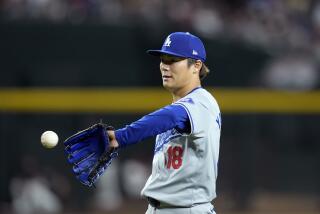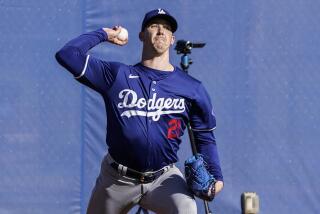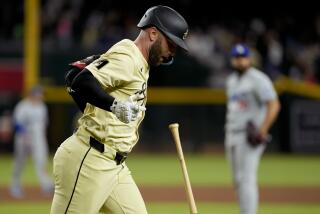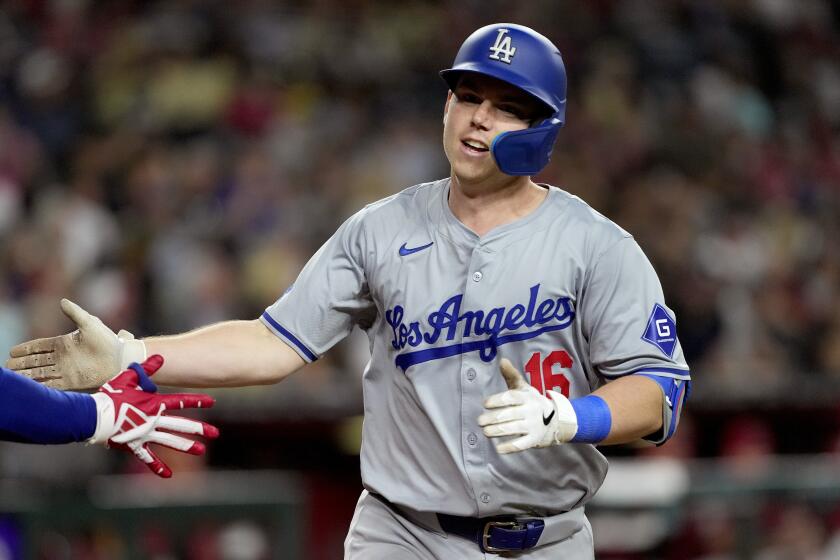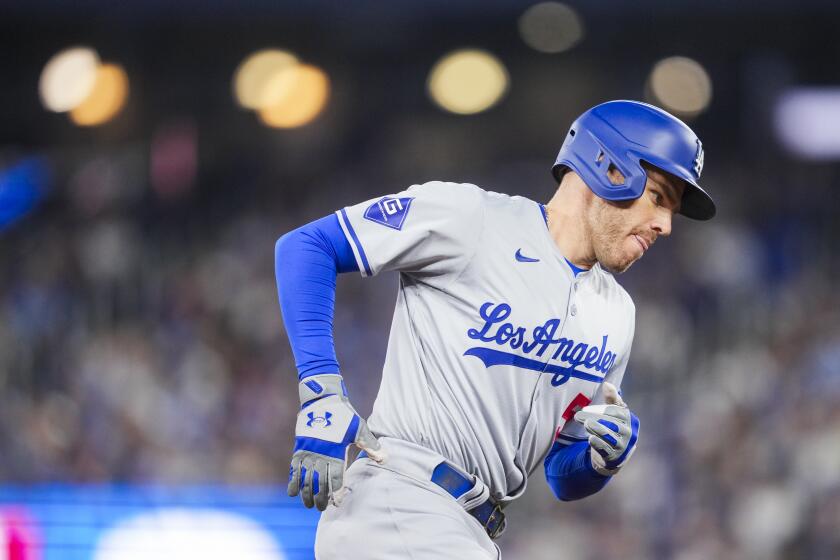Calm Camp for Nomo
Hideo Nomo was known as “the Tornado” when he burst onto the major league scene with the Dodgers in 1995, but he has been more like a soft breeze in 2002.
The right-hander barely caused a stir in his return to Dodgertown. He spent quiet time at his locker reading books, no photographers followed him into the bathroom and he jogged between practice fields almost unnoticed by the Japanese press corps that suffocated him with a full-court press seven years ago.
Nomomania, the craze sparked by the pitcher’s phenomenal rookie season in 1995, has faded, the luster of that All-Star debut dulled by the ignominy of playing for six teams in five seasons.
The Japanese media, once relentless in pursing him, have been dispersed, the influx of Japanese players such as Dodger left-hander Kazuhisa Ishii and Seattle outfielder Ichiro Suzuki deflecting the spotlight.
Nomo, who signed a two-year, $13.25-million contract with the Dodgers in December, still draws a crowd on the days he pitches, but he is no longer a 24/7 story in Japan. He is considered old news and seems more like one of the guys in the Dodger clubhouse.
And he couldn’t be happier.
“In terms of attention, this year compared to 1995, obviously there’s not as many things happening for me,” Nomo said through an interpreter. “At the same time, going through it then, I was somewhat used to it from Japan. In between the lines, I was able to concentrate on baseball. Off the field, I would say sometimes it was disturbing.”
Nomo went 13-6 with a 2.54 earned-run average and a National League-leading 236 strikeouts in 1995 and caused a Fernandomania-like frenzy every time he pitched. Fans unfurled Japanese flags and banners in stadiums around the country, and television broadcasts of his games drew huge audiences back home.
Though reliever Masanori Murakami played for the San Francisco Giants in 1964-65, Nomo was the first Japanese star to play in the major leagues, and his success electrified two countries. One Japanese writer said Nomo was “so fantastic, so stunning, so beautiful ... he’s more famous than Sadaharu Oh.” Nomo’s agent, Don Nomura, called the pitcher “the Michael Jordan of our country.”
Nomo took Dodger Stadium by storm that year ... but it was Nomo who was under siege.
He couldn’t leave his house or go to a restaurant without the Japanese paparazzi in tow. Dodger Senior Vice President Dave Wallace, who was the team’s pitching coach in 1995, remembers photographers hiding in the third deck of Dodger Stadium just so they could take pictures of Nomo warming up in the bullpen.
At the All-Star game in Arlington, Texas, that July, a game Nomo started against then-Seattle ace Randy Johnson, a camera crew followed Nomo into a bathroom.
“I went through Fernandomania [with Fernando Valenzuela in 1981] and then Nomomania,” former Dodger manager Tom Lasorda said. “I think there were more cameras and press following Nomo than there were Fernando. I saw them taking pictures of Nomo while he was dressing, when he went to the restroom. It was unbelievable.”
So, too, was how Nomo handled the pressure and attention. Though he occasionally snapped at Japanese photographers for invading his privacy, Nomo remained even-keeled, almost stoic, throughout.
“No one knew what to expect,” Wallace said. “How he handled it was most rewarding, because he was a rock through the whole thing. People talk about guts and courage.... Had he failed, who knows what would have happened?”
Dodger pitching coach Jim Colborn, who spent four years coaching in Japan, has a good idea.
“There would have been a lot fewer Japanese players in the game today,” he said. “Without question, Nomo paved the way. You need a pioneer to prove that it’s possible, and it takes a special type of person to be a pioneer.”
Nomo didn’t feel like a pioneer. He just wanted to get away from the Kintetsu Buffaloes, the Japanese team that rejected a multiyear deal for Nomo after the 1994 season. Nomo was so disenchanted with Kintetsu that he declared his retirement from Japanese baseball at age 26 and became a free agent.
Nomo signed with the Dodgers, receiving a $2-million bonus, and his overwhelming success in 1995, when he helped restore baseball’s luster after a work stoppage and the cancellation of the 1994 World Series, helped clear a path to the U.S. for other Japanese players.
“The way he did it was wrong; he fought against the Kintetsu Buffaloes,” said Seattle reliever Shigetoshi Hasegawa, the former Orix Blue Wave star signed by the Angels in 1997. “But what he did here was good for all of us. Once he came here, it was a sign that the best pitchers could pitch here.
“He was a star in Japan, just like Ichiro. Now people look at Shinjo [Tsuyoshi, San Francisco outfielder] and realize other Japanese players can play here too. It all changed when Nomo came here.”
Ishii, who signed a four-year, $12.2-million deal with the Dodgers in February, said Japanese players used Nomo as a measuring stick.
“Without Nomo coming here, I don’t think a lot of Japanese players would have known major league baseball as the supreme game in the world,” Ishii said through an interpreter. “Without him, we wouldn’t have grasped the level of play here in the U.S.”
Nomo did well for three years, going 43-29 from 1995-97, but he struggled after being struck by a Scott Rolen line drive in July 1997. He pitched in pain the rest of the season and had elbow surgery to remove calcium deposits near his elbow that winter.
Nomo returned in 1998, but the split-finger fastball that was so devastating for three years seemed to desert him. When then-manager Bill Russell told him he would be demoted to the bullpen after a 2-7, 5.05-ERA start, Nomo asked to be traded.
Off Nomo went to the New York Mets on June 4, 1998, but by the following spring, the Mets released him. Nomo signed with the Chicago Cubs but was released in late April 1999.
He caught on with Milwaukee for the rest of that season, spent 2000 in Detroit and 2001 in Boston, where he resurrected his career with a season-opening no-hitter against Baltimore and a solid 13-10 record, 4.50 ERA and an American League-leading 220 strikeouts.
He has shown signs of the old Nomo this spring, going 2-1 with a 2.37 ERA in five starts. He has snapped off many impressive split-finger pitches, and Dodger Manager Jim Tracy believes the return of that breaking pitch, along with an ability to throw more first-pitch strikes, will make Nomo effective.
He also seems like the Nomo of old; very reserved, very workmanlike, showing little or no emotion. Don’t let that fool you, Wallace warns.
“He’s not detached at all; that’s just his personality,” Wallace said. “He doesn’t miss a trick. He knows exactly what’s going on with the team, in the clubhouse and on the field. He and I speak with facial expressions.”
Nomo seems content to play a supporting role--he’ll probably be the No. 2 starter behind Kevin Brown this season--and he seems happy to have passed the torch bearing the Japanese media’s hot glare to the younger Ishii.
“This will be different than 1995, but I’m looking forward to it in a different way,” Nomo said. “In 1995, I was just happy to be on the mound. This time around, I just want to go out there and win. I’m not too concerned about what everyone else’s expectations are. My priority is winning, and if I can help the Dodgers get to the World Series, I will be happy.”
*
(BEGIN TEXT OF INFOBOX)
Nomo’s Numbers
(text of infobox not included)
More to Read
Are you a true-blue fan?
Get our Dodgers Dugout newsletter for insights, news and much more.
You may occasionally receive promotional content from the Los Angeles Times.
